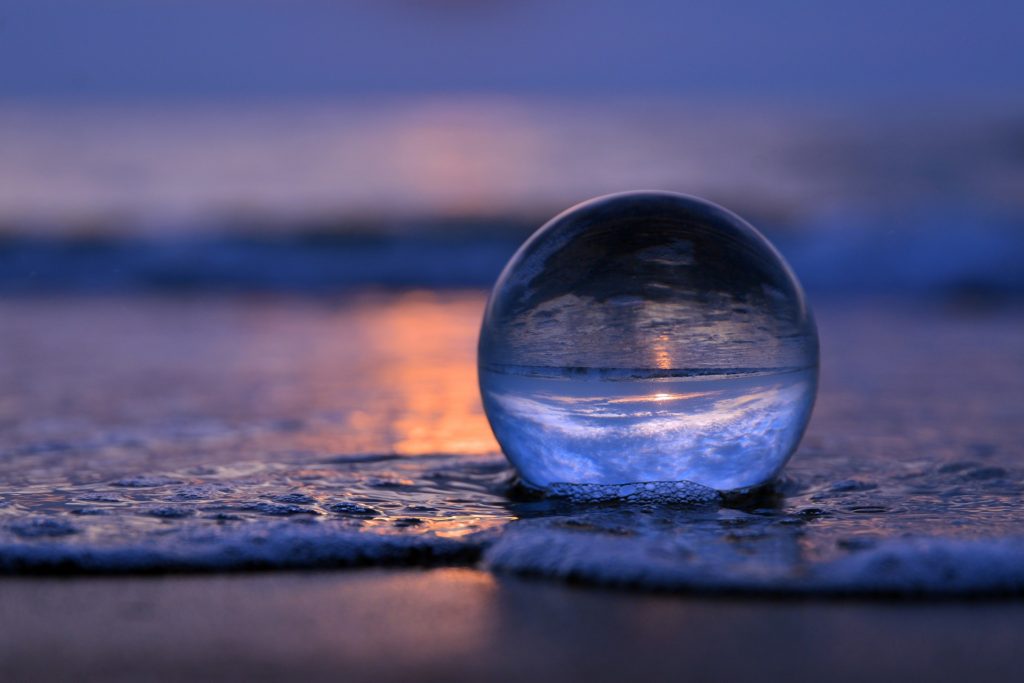
Do you know what I love in science fiction and fantasy? Landscapes that defy logic. Rock formations that seem to have no conventional shape. Floating islands.
Floating islands are a known feature of some speculative fiction worlds. Anime. High fantasy. Science fiction. There’s a profound image of a beautiful land mass floating above the world, exhibiting its glory despite the powers of gravity,… almost flaunting its specialness.
A long waterfall pouring down from its edge, fed by a lake or stream that seemingly has a never-ending supply of the stuff.
It defies logic in so many ways, and I could write up an entire article on all of the ways floating islands are impossible, but… they’re just so freaking cool!
They are the ultimate expression of the “Rule of Cool” in world building.
Aerials, in the sky...
As someone who embraces the wild throes of the imagination, I don’t see a problem of physics; most writers could come up with any sort of magical, fantastical, and faux-scientific reason for them existing, just enough to … “suspend” the readers belief enough for them to accept it.
Here’s an example…
Take an early, renaissance or pre-victorian scientific understanding, entwine it with a comprehension of magics existence or its intertwining with the worlds knowledge of things, come up with fancy nomenclature, a casual nickname (Example:“mule-ish matter”), create a fictional ideological debate of why this thing exists but with no conclusive answer, and have certain supporting characters explain all of this in the middle of an argument for the reader to see.
Done! Floating island, confirmed!
One of many ways to explain their existence!

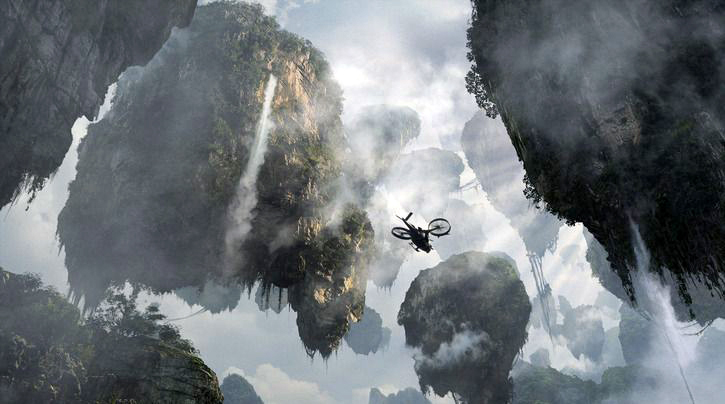
Taking it further.
I’m not here to talk about whats been done; they’re a known trope in speculative fiction media.
I’m here to up the ante! … I’m here to push the boundaries of awesome!
And in order to up the ante, we have to ask the hard questions! For instance, why do floating islands always need to look like shattered fragments of pristine, natural, temperate utopia? Why not put Mordor on a floating island? Why not a tropical or jungle trees with an ancient Mayanesque temple? Why not floating glacial shards, or a one with a snow-covered wonderland? Imagine those giant waterfalls from island to island completely frozen over?
Also, what’s with the shape? Either they’re a flat plane that basically an inverted cone like it was plucked right off the ground, or some giant egg-like bolder made of massive bluffs with broccoli on top. How come we never see rings made of stone, or a floating basin that acts like a bowl, being fed by other waterfalls. Or a hot dog! I’m just saying,… we’re already committing to fantasy here.
And by the way, there’s always waterfalls in these images, where did all of that water come from in the first place? Seriously.
Why does land need to be the only floating, terrestrial concept? Why not… for instance…
Enter "Floating Oceans" - An alternative to islands!
Now, you’re likely thinking a number of different things at this point.
- Wait. How does that even work physically?
- How can you have an ocean without land?
- How could an ecosystem even exist?
- What’s wrong with just sticking to floating islands?
- What would this weird anomaly even look like?
All of these questions, and more, are entirely valid! … However, keep in mind that I’m limiting this to a thought experiment within a speculative fiction universe with no strict obligation towards reality. Coming from the realm of science fiction and fantasy, we have quite the range of concepts to work with!
However, the closer we can orbit a sense of (perceived) realism, the better the thought experiment.
Naturally, when taking oceans, the habitat would require some earth to provide things like reefs, flora, rocky fissures, geothermal vents, and general nesting and hiding places for prey and the like. With each example, imagine the mass of such a place contains the necessary things to make these hovering aquariums feasible, and is likewise, floating with the ocean.
I won’t pretend to be an ocean biologist, geologist, or someone who knows anything about what sustains an underwater biome. Its obviously far more than combining water, fish, plants, coral, etc.
However, wouldn’t it be just unfortunate as a world builder to have to factor in overly precise things like the pH level of the water, or what precise subspecies of coral, or the specific migration patterns of hundreds of different aqueous creatures relative to the seasons in very specific parts of our magnificent floating ocean?
Even if you’re a nerd like me, and enjoy researching things you never knew before, at some point you’re simply going to burn out on the details. (Unless you’re an ocean biologist.)
So, lets take a tour through this fictional wonderland. Let’s have a good think, and see what cool creations we can assemble. First question being: what shape does this thing take, and how does the ecosystem play out?
(And since I have a new iPad with a Stylus, lets have some fun with this!)
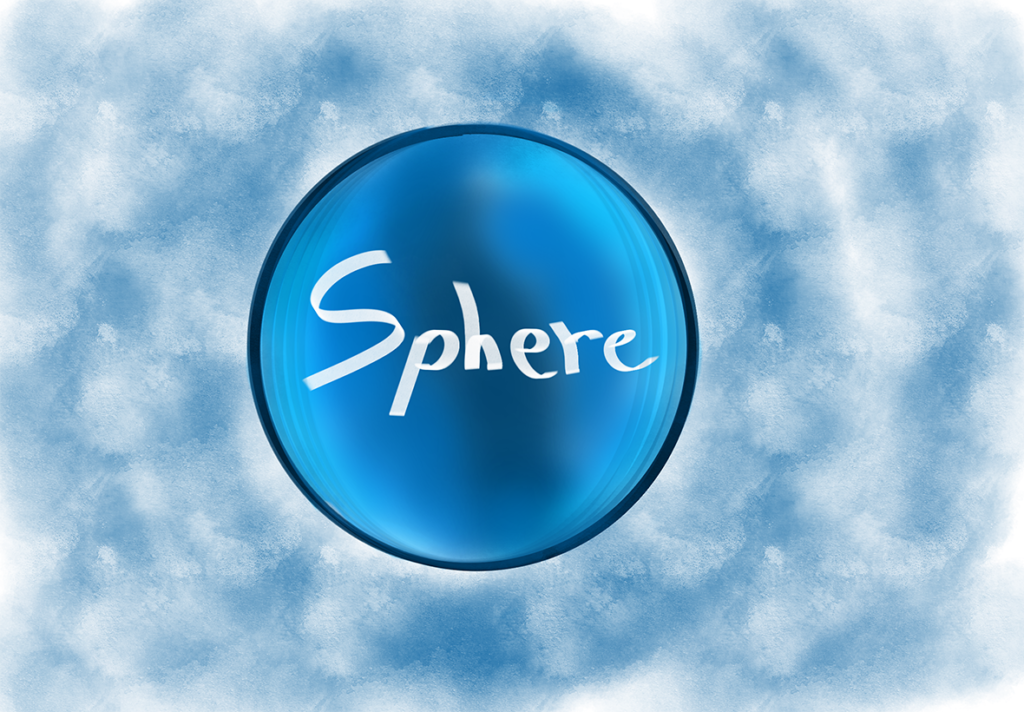
Giant Water Sphere
First stop on our journey, the classic round orb. A colossal fishbowl of various plants, fishes, and underwater creatures with infinite surface, and a central point of immersion. If we are talking about an ocean, this would need to be a massive form, but smaller than an ocean planet. Perhaps a sea or large lake would be enough. We might need to tweak gravity a bit to keep all of the fish from falling out, but it is possible that cultures of oceanic creatures have evolved or adapted to… know… stay away from the surface, or grow wings to allow flying or gliding back into the sphere.
Something this large might struggle to be an exact sphere, likely being pulled by tidal forces. Waves across the surface might be a noise of ripples, the motion of the water at odds with the force containing the sphere. A current clockwise or counter clockwise might be present, or a current from the center pushing to the poles, across the surface, and inward from the equator. How would all of these factors influence the kind of life that exists in this place?
So many possibilities.
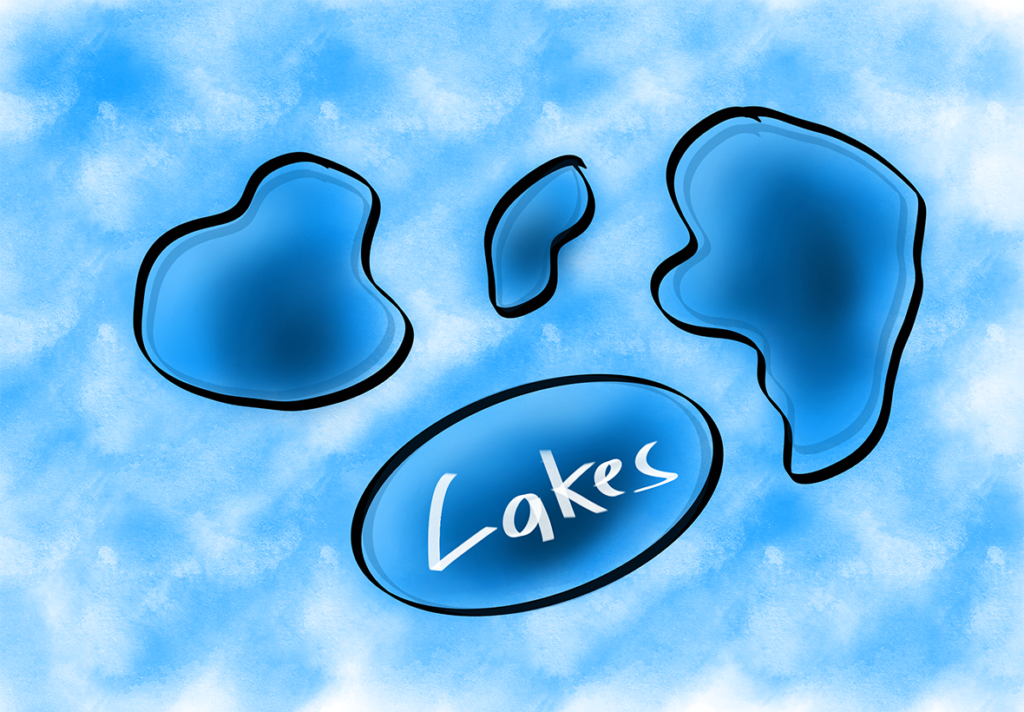
Roaming Globules/Lakes
Instead of a massive sphere, we can imagine this ocean more as a scattering of lakes or small seas. Multiple spheres or globules floating along one another, connecting and separating at one point or another, like wandering bubbles.
Another mode of thought is to imagine a lava lamp, minus the lava. These globules could be exchanged from a watery source above and below it, moving between due to heat and cooling.
Life in this place would be… interesting. Definitely the need to justify fish with wings, fauna that can adapt to changing temperatures, and migrating reefs. In a way, this is more like floating islands than a floating ocean,… except those islands are completely submerged. A scattering of various fishbowl habitats drifting and bouncing around each other.
On one end, you can see how a seafaring adventuring party might find this environment complex to navigate. On the other, a starship flying past might treat it like a less dangerous astroid field. As a basis for a scene, setting, or world feature, we have an entirely new set of material to work with!
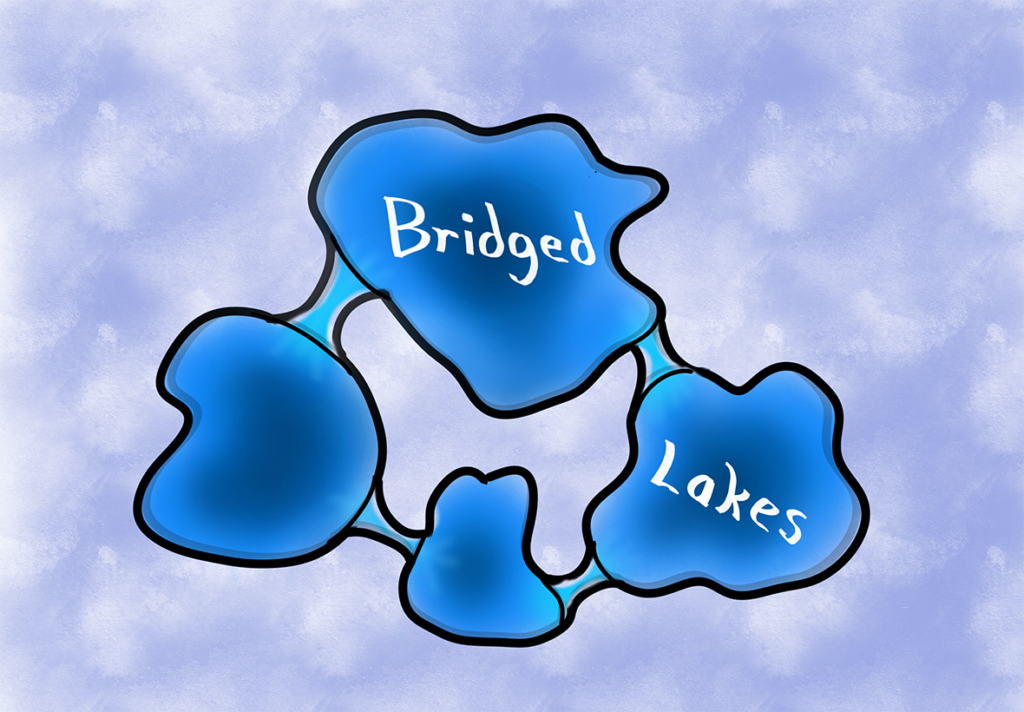
Bridged Lake Network
Now, imagine the same thing, except not completely independent. Imagine something like a web, or neural network of floating bodies which together makes up the ocean. Same concept with the scattering of reefs, except tunnels exist between each of the smaller bodies. Currents might develop between these connected tunnels, allowing migrations of fauna to cycle through each of these seas/lakes. Less need for wings this way.
There might be a sense of individual lakes growing and shrinking as water fills or drains from each. Some places, this would have to take place slower than others, or not at all, since some calm water would need to exist to allow places of birth to remain safe (Unless life has adapted to this feature as well).
If the network was thick enough, you could also see this in the inverse; a single ocean with a lot of connecting air tunnels and air pockets. Basically, Underwater World at the Mall of America times a thousand.
Speaking of tunnels…
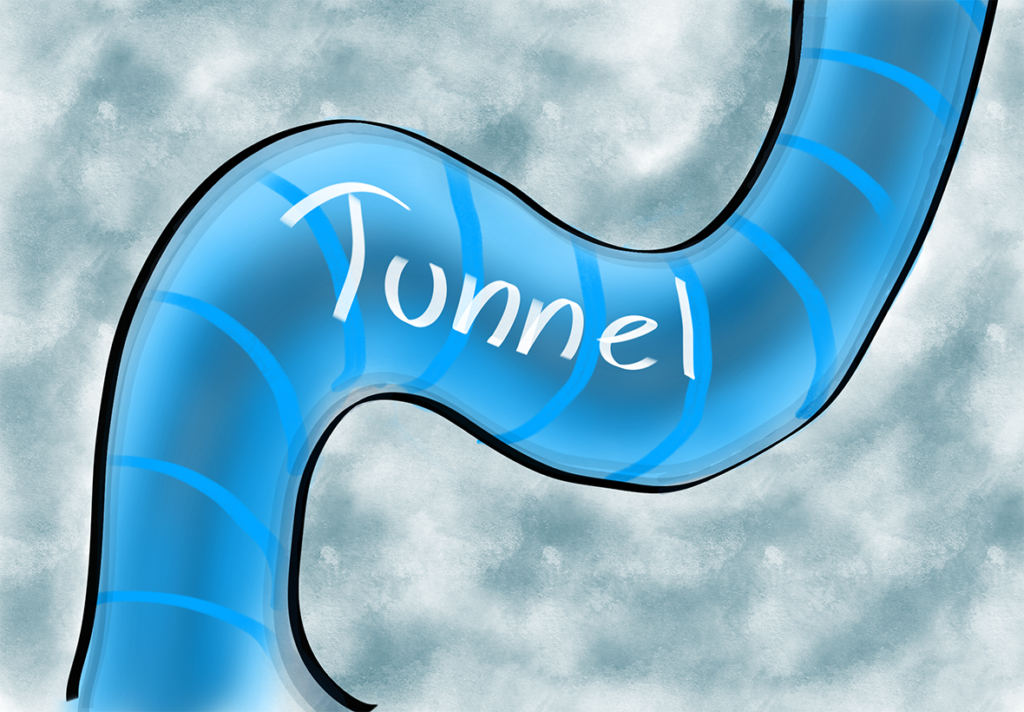
Serpentine Tunnel
I’ve had an early fascination with water spouts and tornadoes in general. Obviously extremely turbulent weather events. However, what if this water spout was absolutely massive, and the twisting of it was no faster than a normal ocean current?
We’re obviously talking about a constantly moving and bending shape, either like a gargantuan noodle, or a two-sided draining vortex of air against liquid, rather than liquid against air. An inverted maelstrom, but gentler.
I’m talking massive.
The outer edges of it would be the most turbulent. I imagine its a constant hazard for any creature to find themselves in a current to be sent to the outermost part, and potentialy thrown from the whole thing. Except, I think of this exterior less like an unfortunate fishy slingshot, and more like a constant wave formation one could see dolphins or dolphin-like creatures leaping in and out of. Salmon leaping upstream forever (but not really).
Calmer towards the center, the earthen masses making up the bed of the coral reefs are drifting lazily, allowing for a variety of species to thrive, all of which would have some adaptability to strong currents. This constitutes some sort of body of water above and below where this spout is connecting to. That, or a top of the spout like the cap of a pillar of water. Flying fish confirmed.
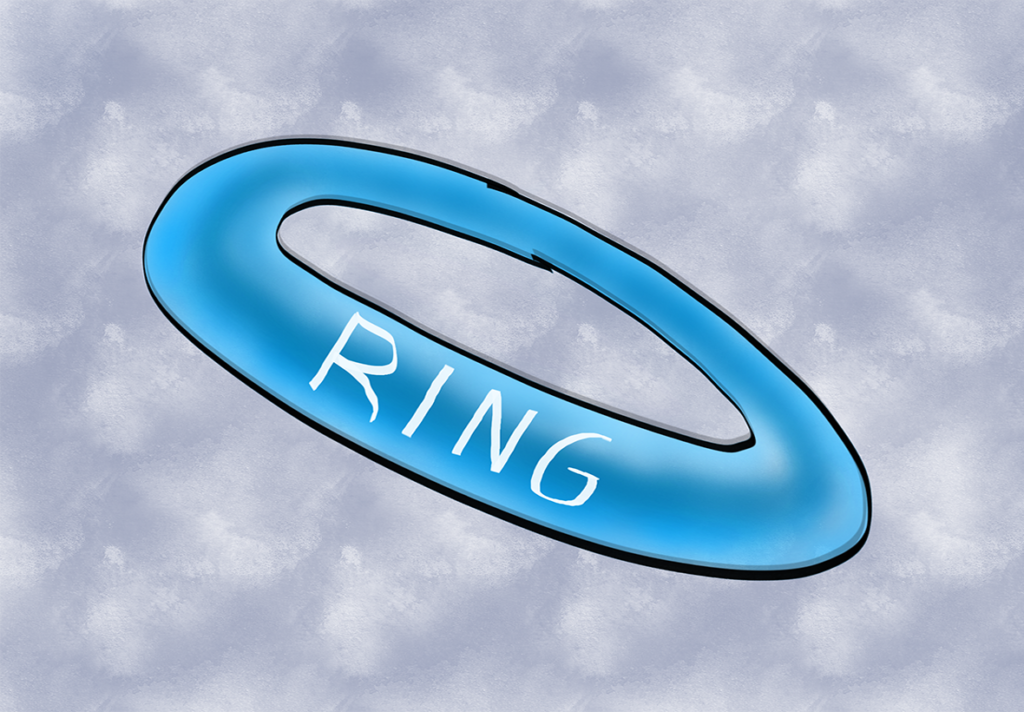
Ring Formation
We enter a realm of constant motion. One shape which might have such a constant motion, or might be mostly static except for a jet stream or two, is a ring formation. Taking the rotating motions of a water spout with the relative thickness and shape consistency of a sphere. It would bend and wiggle a bit, but it keeps its ring shape regardless.
One issue is that there would need to be two currents, each going in either direction to allow for better migration of fauna. Otherwise, a single jet stream creates a sort of “one way ticket”. Yet, if there was a one-way current around the ring, I imagine the life that exists in this ring would be in waves; a wave of fish constantly chasing a wave of plankton, a wave of predators constantly chasing the wave of fish, a wave of super-predators, a wave of scavengers that feed on dead super predators, which in turn break down the remains into something that feeds a wave of undersea plants, of which are plankton friendly, and so on.
Of course, this shape requires that something in the center is both pulling the water forward, and repelling it at the same time, or just one. Perhaps its a different force altogether.
If you enjoy this idea, but would rather there be a center to it, maybe a disc shape is more your speed.
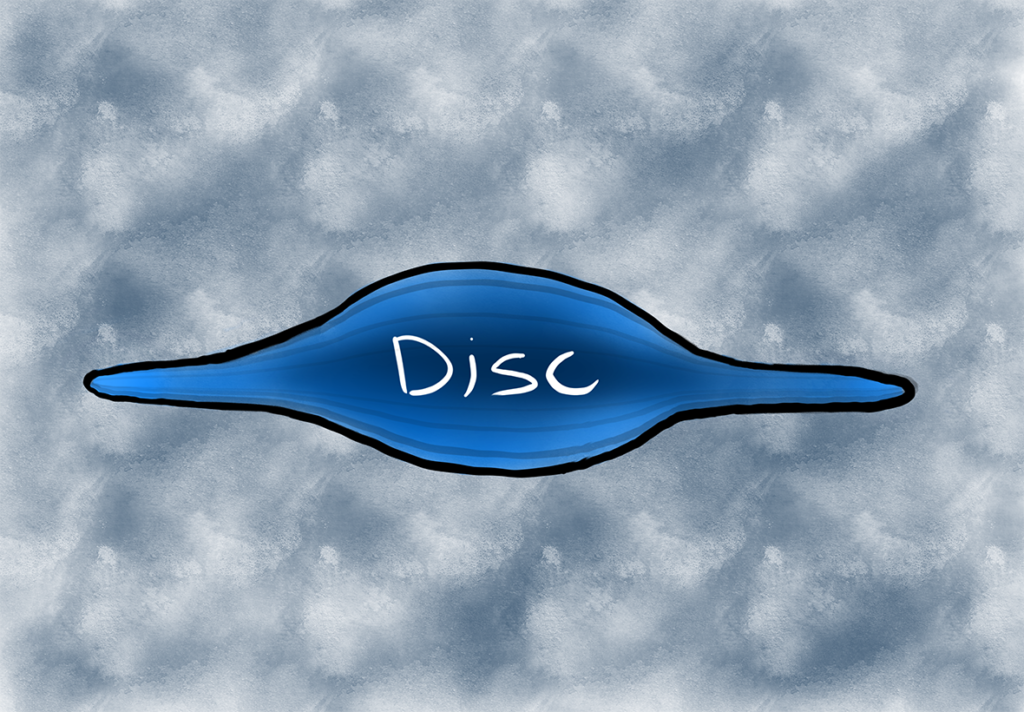
Disc Formation
My immediate impression is that of a spinning toy, or like a galaxy. Thick in the middle, and thinner on the outside. Relative calm in the center, and more turbulent in the outer rings. Yet, the turbulence is really an assumption if nothing else; perhaps the outside drifts lazily compared to the vortex spinning at the center.
This shape is much more how I would imagine the sphere formation, except much flatter. Depending on the details, the top and bottom surface might be slanted with the growing thickness towards the center, or flat like a wafer or plate. A humungous, watery pancake.
You could almost see the top of the formation much like a normal ocean surface. There could even be floating islands above the waves with all of the characteristic features of an archipelago, large island, or central continent. Perhaps a handful of floating continents.
Perhaps it looks like earth.
Perhaps I just invented a new flat-earth theory by mistake.
Excuse me while I punish myself.
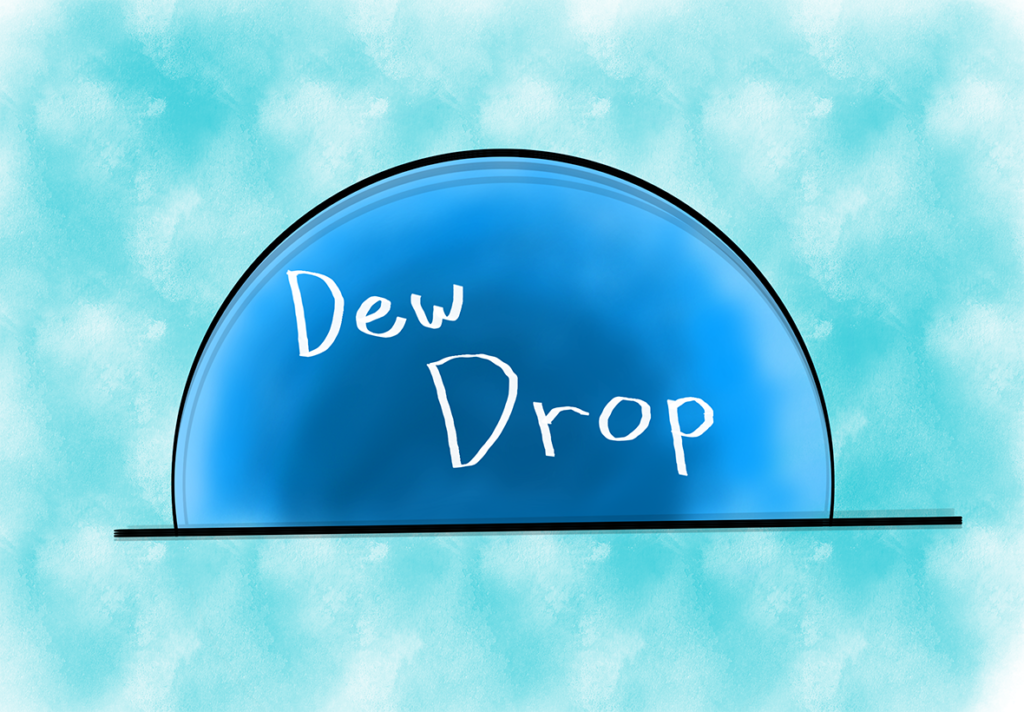
Giant Dew Drop
Hell. Whose to say that the water in this ocean has to be separate from a terrestrial surface. Perhaps it is embedded into the world like a real ocean. … Just the same, whose to say that the ocean needs to settle into the gaps between land masses?
Whats to prevent that ocean, sea, or lake from being one big bubble of a dew drop, atop or on the bottom of a huge mass of land? Here, you have all of the hallmarks of a normal ocean, except instead of its bottom/top and edges being surrounded by land, its surrounded by air.
Here, you can imagine it with any combination of concepts reviewed with the above hallmarks. Currents spinning around or throughout the mass, while migrations follow paths throughout floating coral reefs, except now those reefs can exist in a static place as well. Segments divided between edge and center, away from and towards the attached surface create a variety of miniature biomes.
Think of a sphere formation, cut in half, and placed upon or beneath a rocky surface, almost like a giant, gelatinous glop of goo.
Gelatinous. Like jello (on its exterior at least).
Gelatinous.
Like a… monstrous gelatinous cube?
Woah!
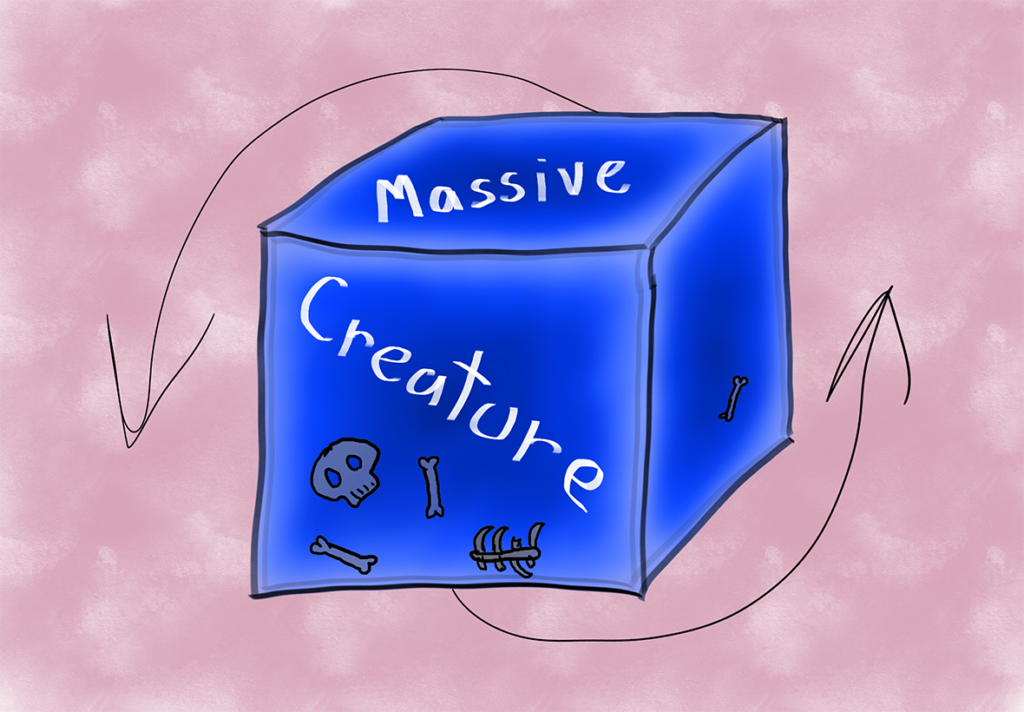
Massive Creature
Hear me out!
If we’re going to far as to create an ocean that defies logic, why does it need to be stationary? It could be moving. It could be a creature; one that moves across a land, gaining organic material which the fauna inside then thrive off of. The creature could be intelligent, and completely symbiotic (or dependent) on the complex of life inside of the thing. An ocean alive!
Then again, whether the ocean itself is a creature, or the ocean is within the belly or body of a massive creature, it qualifies as a living ocean. The creature would need to be significantly larger than the ocean itself, but you could take any creature and tweak it to be biome carrying; a turtle with the ocean in its shell, a continental whale, a never-deflating puffer fish, a titanic jellyfish with a sea within its jelly body. Beak of a pelican. Shell of a snail. A slug, A frog. Big insect.
A dog.
A water dog.
Clifford, the big, red, Pacific dog!
Look how big this dog is!



Explaining the thing!
This part sucks (or rocks, depending on your tastes)!
Mostly because this is all quite impossible. The further we push the barrier of imagination, the further from reality we travel. Modern minds require modern explanations. They require well-crafted calculations, and hypotheses that have been proven by controlled experimentation, not to mention acceptance by the scientific establishment by peer-reviewed publication.
Thankfully, you’re a world builder!
Which means you’re a wizard, and logic does not apply to you!
Therefore, I’ve crafted a handful of spicy explanations that would explain away some of this meddlesome prodding of science. It should be obvious that ALL of these explanations are pseudo-scientific, and in the realms of soft science-fiction and fantasy. Therefore, the onus is on the writer or the person explaining to suspend the readers belief either with sensible-sounding jargon, ornate description, and/or simply standing by the “rule of cool”. If that doesn’t do the job, and science is required, then I will allow someone else to the calculations, myth busting, and the scientific theory.
Mega-Tides and Contesting Gravity
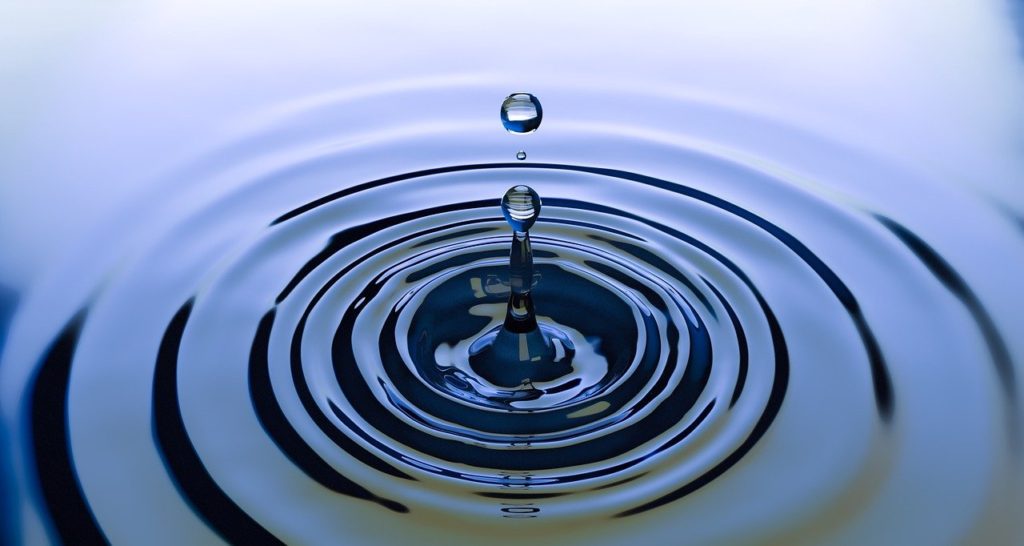
I’ll confess, I love gravity! Not simply because it keeps me from floating in the air, but because its a force in this universe that creates all sorts of interesting phenomena. Celestial objects orbiting each-other, and tugging on each others trajectories. Even if you’re far away, the gravity of any one distant object can affect you.
What if they’re not distant. Imagine you have two large planets orbiting each other, within close proximity, pulling on one another. Probably, the planet would start breaking apart by now, but what if not? What happens in the middle? If I was somehow floating in the middle, in perfect equilibrium, would I completely still? Or spinning uncontrollably? What if both objects were planets, tidally locked, not breaking apart, with a surface that was dominantly water. Enough water on both sides to create, through the powers of gravity and all that is otherwise unscientific, a connecting ocean.
What sort of properties does that kind of environment create? Is it constant, or only during a certain period of time?
Gravitational Disruption Field
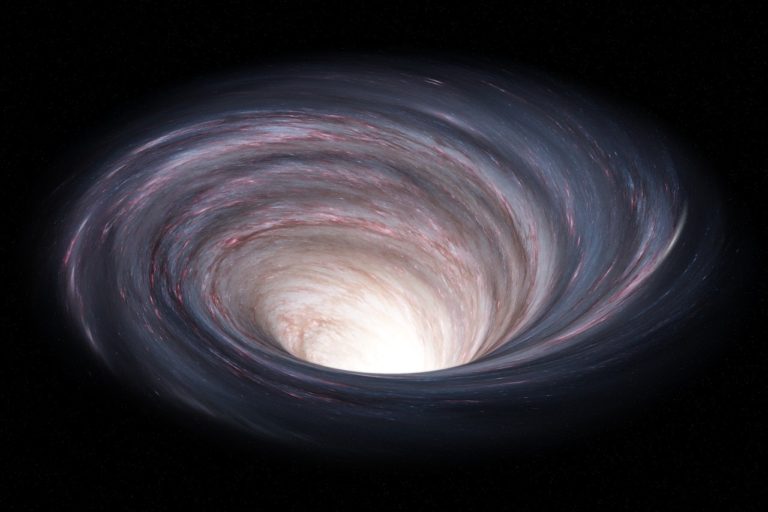
Anything that has matter in this universe has gravity, however small or large. When visualizing gravity, we see it as a curve of sorts in the fabric of space-time. That curve is always downward, meaning that gravity pulls inward, whether that be an asteroid, a planet, a star, or (the intergalactic heavyweight champion of gravity) a black hole.
Yet no point have I (and most science loving people) ever been aware of anything where the fabric of space-time curves upward, meaning that things fall away. This makes for an entire concept of anti-gravity. Does such a thing even exist in the cosmos, or is it completely speculative, or is it simply undiscovered?
My answer is…
Yes!
All of the things!
Perhaps a force of advanced technology, unseen phenomena, or wizard magic creates an artificial center of gravity, or a property of the liquid that partially negates the gravity of its home world, or an anti-gravitational area that separates one ocean from another. Clearly, its a phenomenon that upsets the natural order.
A Dense Core; Natural or Artificial
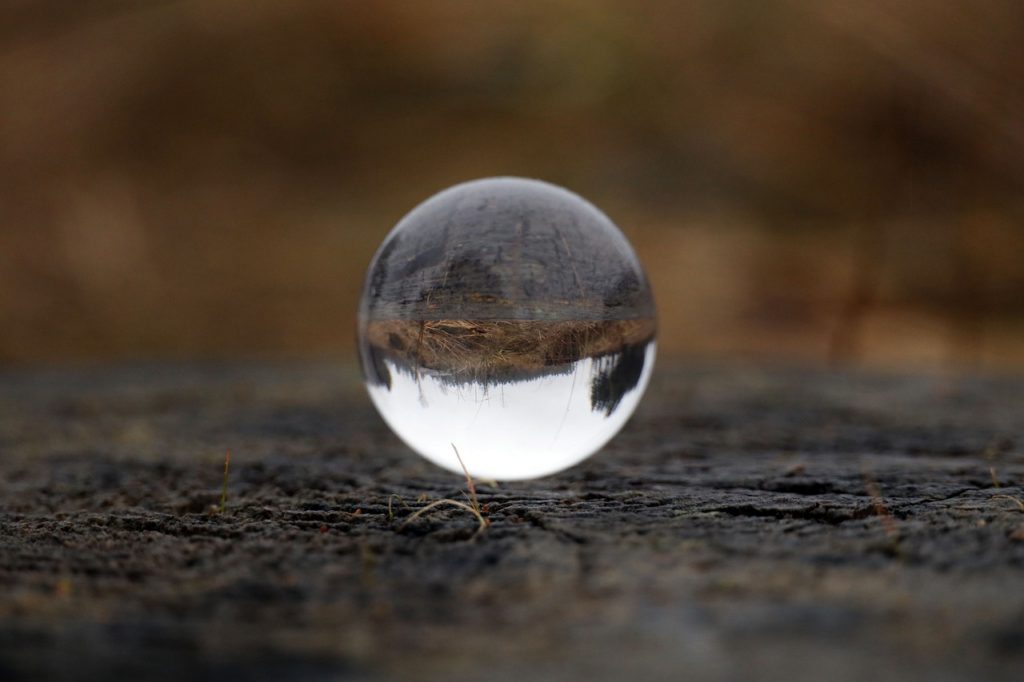
More fun with gravity! Except now, we have a problem of consistency. Obviously too much gravity makes for a deadly experience. Too little gravity breaks our fabulous water world. We could go with something as simple as an ocean planet, but that not why we’re here! … We’re here because we want an ocean! …. That is… an ocean on a planet, without being on the planet.
So why not give that ocean a core much like an ocean planet, but condense it down into a much smaller space.
Short scientific version: we just created a black hole, thus negating our entire project. The end.
Except, once again, we’re fantasy world builders!
We laugh in the face of logic if it helps us tell a story!
So, I propose a central solid core which commands the gravity necessary to keep it together, separate from the gravity of the world, where the field of gravity is not a complete sinkhole. Perhaps an artificial orb that creates this effect. Maybe a special kind of matter yet undiscovered. Or a super tiny black hole with a super stable dyson sphere that separates the water from the event horizon. Or… magic!
You can’t go wrong with magic!
Force Field / Bubble / Glass
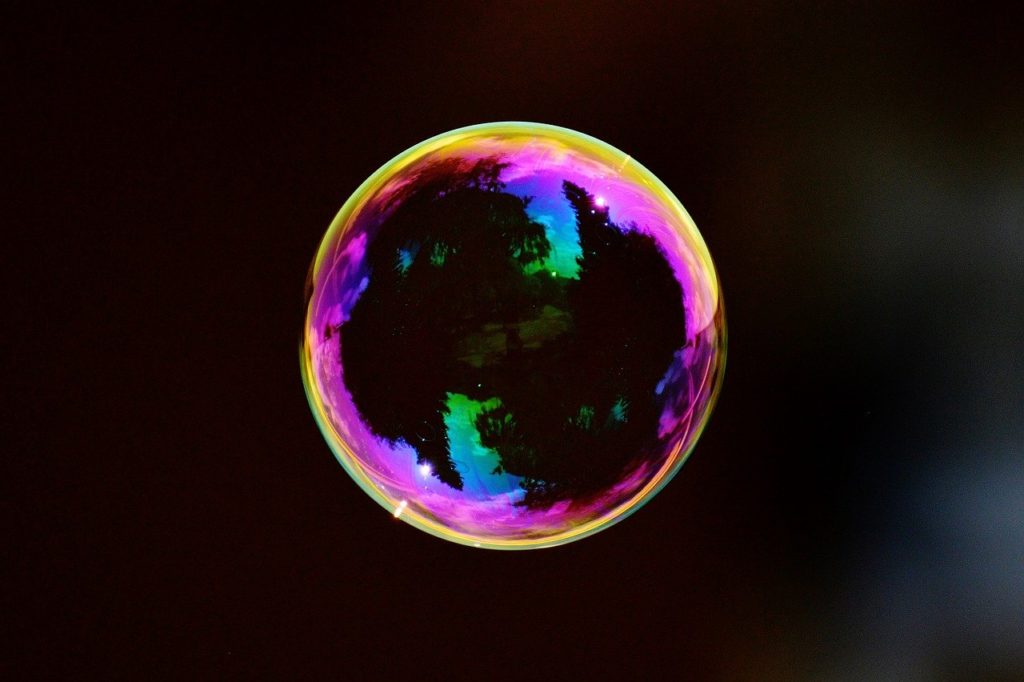
So, let’s just avoid all of this talk of gravity. We’re only further breaking the “hard science” barrier by talking about impossible things. Perhaps we don’t need to misuse this cosmic force to justify anything. It could be as simple as a containment of water. While it eliminates the idea of the ocean itself to be floating, it does provide an option to allow something to give such an ocean its “floating” characteristics.
All we need is a force or object strong enough that can contain that much water, that is also… not connected to the terrestrial surface.
If we want to speculate with technology, we can borrow the concept of “force fields”, an arbitrary wall of force which separates or contains physical objects. Something needs to be generating that force field, whether its central to the ocean, or from a remote location. We can argue that the generator is not a machine. Perhaps it IS the force field itself. In any case, a weightless barrier that holds a body of water in suspension can fit most science fiction or fantasy settings while justifying our ocean.
Not satisfied with the magic or technology behind this idea? Perhaps then, something built of matter is containing the ocean. A bubble of extremely flexible, extremely strong, tension resistant material which also permits a level of transmissibility either between bodies of water, or to allow intrepid explorers to enter and exist.
Or, we can go the full fishbowl route and build this thing out of pure glass. Obviously, that needs to be SUPER thick glass. An aquarium of the gods! Forged in the fires of the deepest terrestrial desert by fiery titans! … Or a complex, but massive Prince Ruperts Drop!
(Google it. Thank me later.)
It’s Magic! … Explanation is Irrelevant

Ahh yes! The most minimal, but least demanding route.
The path built of sheer self-confidence, personal willpower, and… belief!
I don’t recall J.R.R. Tolkien describing why the …, or Hayao Miyazaki explain the origins of river spirits in Spirited Away, or the physics of Howls Moving Castle beyond “Billy Crystal and his fire demon magic”. With enough imagination, elegant description, and a profound sense of wonder, one can raise mountains from greif, pour all their evil into a ring, or make a spaceship go faster by believing strongly enough in it.
Matthew sometimes wishes he could float aimlessly in the air. If you enjoyed his romp into unconventional worldbuilding concepts, the please check out some of my other worldbuilding articles listed here:
IMAGE CREDITS:
All concept drawings were done by me on my iPad. Stock images by Stefan Vögeli, Photorama, Alexander Antropov, Alexas_Fotos, qimono, from Pixabay. I do not claim the rights of any mass media images or memes.
- Axolotls, Genies, and Kaiju; a Quick TTRPG Zine Roundup #2 - May 19, 2025
- d100 City Encounters and Urban Sidequests - April 26, 2025
- Dirtbags! a Sci-Fi Shooter RPG: Gameplay Review! - March 23, 2025


